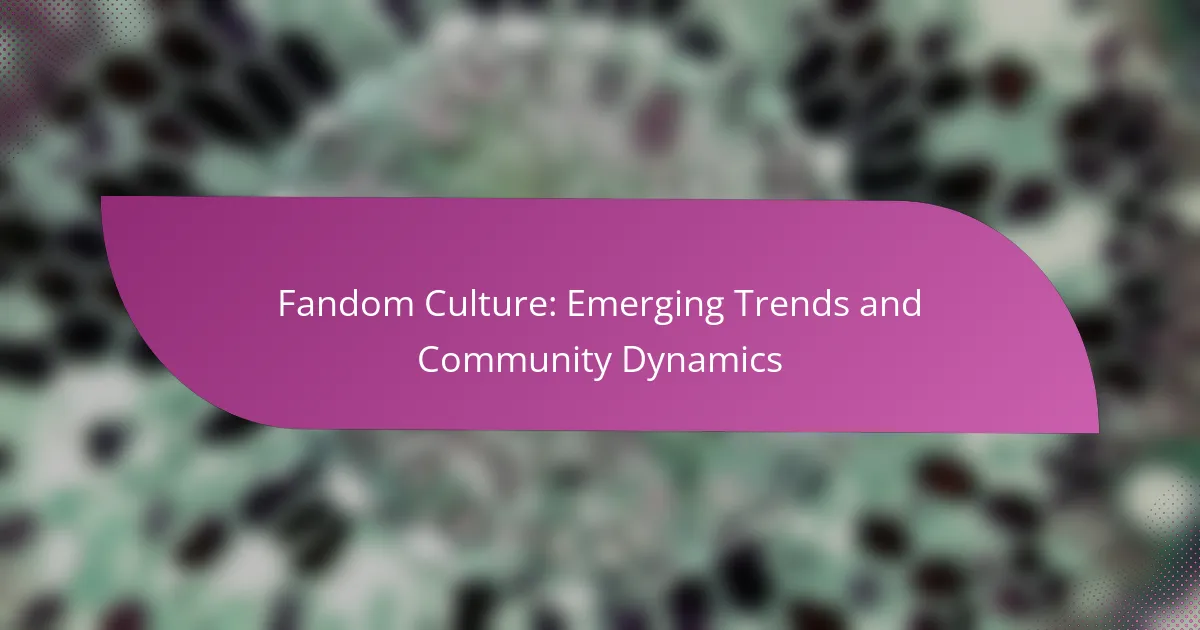Fandom culture is evolving rapidly, driven by emerging trends that reshape how fans connect with their interests and each other. With the rise of virtual events, greater diversity, and the incorporation of technologies like augmented reality, fans are finding new ways to engage and collaborate. These communities thrive on shared passions, fostering creativity and support while navigating the complexities of interaction and conflict within their networks.
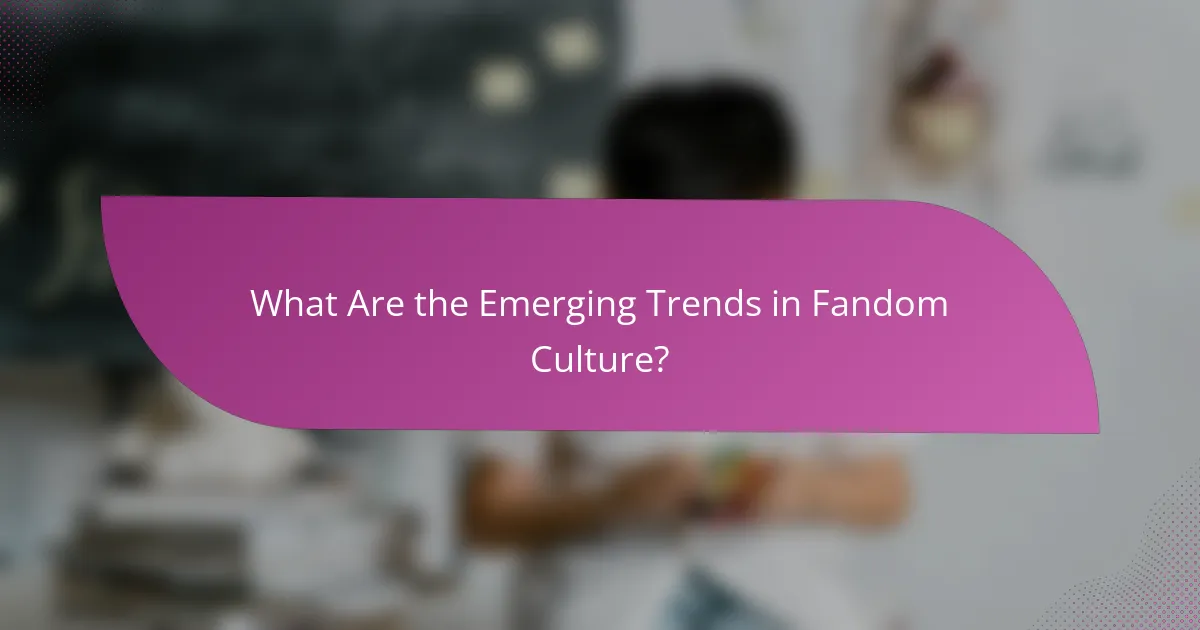
What Are the Emerging Trends in Fandom Culture?
Emerging trends in fandom culture reflect shifts in how fans engage with their interests and communities. Key developments include the rise of virtual events, increased diversity, and the integration of new technologies like augmented reality.
Rise of Virtual Events
Virtual events have become a staple in fandom culture, allowing fans to connect regardless of geographical barriers. These events often include live streams, online conventions, and interactive Q&A sessions, providing a platform for fans to engage with creators and each other.
For example, major franchises like Comic-Con have adapted to online formats, attracting thousands of participants who might not have been able to attend in person. This shift has made fandom more accessible, enabling a broader audience to participate in discussions and activities.
Increased Diversity in Fan Communities
Diversity within fan communities is growing, with more representation across various demographics, including race, gender, and sexual orientation. This trend fosters a richer dialogue and encourages the creation of content that reflects a wider range of experiences.
As communities become more inclusive, they often see an increase in collaborative projects, such as fan art and fan fiction that celebrate diverse narratives. This inclusivity not only enriches the fan experience but also challenges traditional norms within fandoms.
Integration of Augmented Reality
Augmented reality (AR) is increasingly being integrated into fandom experiences, enhancing how fans interact with their favorite franchises. AR applications allow fans to engage with characters and settings in immersive ways, bridging the gap between the digital and physical worlds.
For instance, mobile apps that use AR technology enable fans to see characters from their favorite shows in their own environments. This interactive element creates a more engaging experience and encourages fans to share their encounters on social media.
Cross-Platform Engagement
Cross-platform engagement is becoming essential as fans interact with content across various media. Fans now seamlessly move between social media, streaming platforms, and gaming environments, creating a cohesive experience that enhances their connection to the franchise.
For example, a popular series might have a dedicated fan base on platforms like Twitter for discussions, YouTube for fan videos, and Twitch for live gameplay. This multi-faceted engagement allows fans to express their passion in diverse ways, fostering a sense of community.
Influence of Social Media
Social media plays a crucial role in shaping fandom culture by facilitating communication and content sharing among fans. Platforms like Instagram, TikTok, and Twitter allow fans to express their creativity and connect with others who share their interests.
Through hashtags and trends, fans can participate in larger conversations and discover new content related to their favorite franchises. This influence has led to the rise of fan-led initiatives, such as charity drives and collaborative projects, further strengthening community bonds.
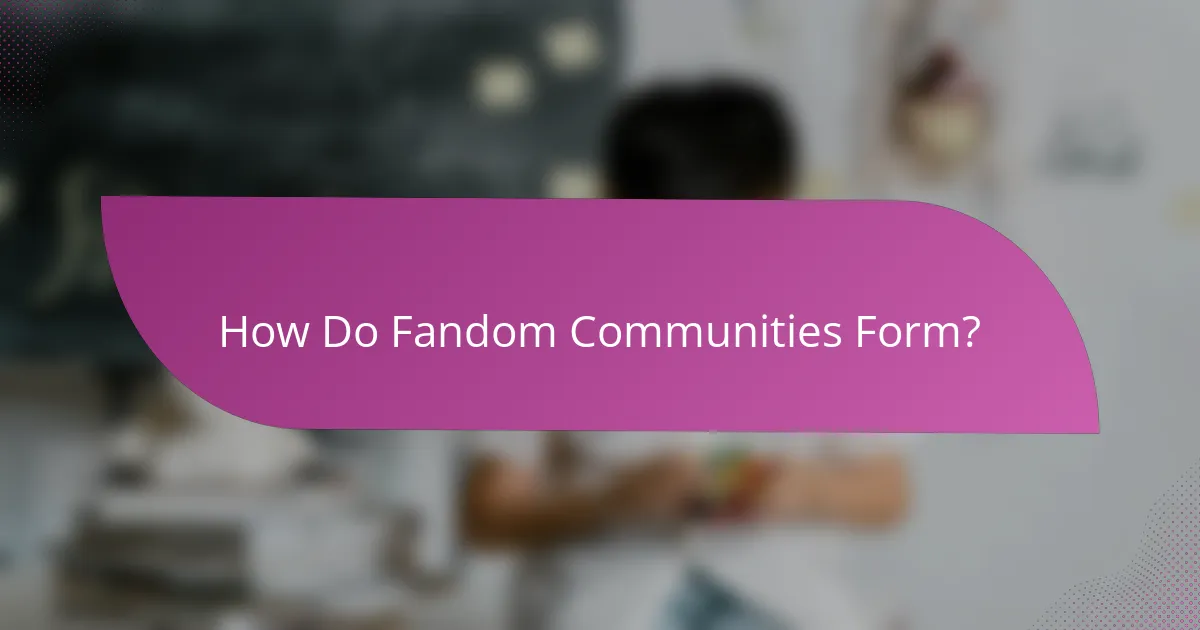
How Do Fandom Communities Form?
Fandom communities form through shared interests in specific media, such as movies, books, or games, where individuals connect over their passions. These connections often lead to the establishment of networks that foster collaboration, creativity, and support among members.
Shared Interests and Passions
At the core of any fandom community are the shared interests and passions that unite its members. Fans often bond over specific characters, storylines, or themes, creating a sense of belonging. For example, a group of fans of a popular fantasy series may gather to discuss theories, share fan art, or organize events.
These shared passions can lead to the creation of sub-groups within the larger fandom, allowing for more focused discussions and activities. Fans may engage in role-playing, fan fiction writing, or cosplay, further deepening their connection to the material and each other.
Online Platforms and Forums
Online platforms and forums play a crucial role in the formation and growth of fandom communities. Websites like Reddit, Tumblr, and Discord provide spaces for fans to interact, share content, and discuss their interests in real-time. These platforms often feature dedicated channels or threads for specific fandoms, making it easier for members to find like-minded individuals.
Additionally, social media platforms such as Twitter and Instagram allow fans to share their creations and connect with others globally. This accessibility fosters a sense of community, as fans can engage with each other regardless of geographic location.
Influence of Content Creators
Content creators significantly influence fandom communities by producing original works that resonate with fans. These creators, including authors, filmmakers, and artists, often engage directly with their audience through social media, creating a feedback loop that enhances community involvement. Fans may feel a personal connection to creators, which can strengthen their commitment to the fandom.
Moreover, the rise of platforms like YouTube and Twitch allows fans to consume content in diverse formats, such as reviews, analyses, or live streams. This variety not only enriches the fandom experience but also encourages fans to contribute their perspectives, further solidifying community bonds.
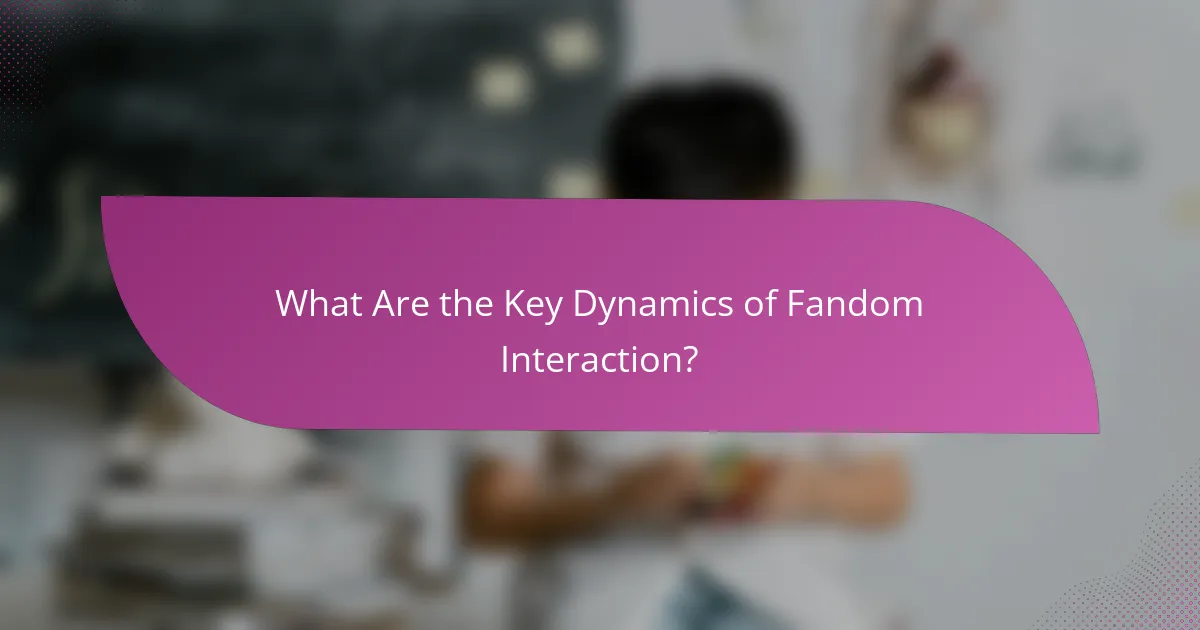
What Are the Key Dynamics of Fandom Interaction?
Fandom interaction is characterized by collaboration, conflict, and community-building among fans. These dynamics shape how fans engage with each other and the content they love, influencing both individual experiences and the broader culture of fandom.
Collaboration on Fan Projects
Collaboration in fandom often manifests through fan art, fan fiction, and various multimedia projects. Fans come together to create content that expands on their favorite universes, often sharing their work on platforms like Tumblr, Wattpad, or dedicated forums.
These projects can range from small group efforts to large-scale productions, such as fan films or conventions. Successful collaborations typically require clear communication, defined roles, and a shared vision to ensure that all contributors feel valued and included.
Conflict and Debate Among Fans
Conflict in fandom can arise from differing interpretations of source material, character motivations, or even production decisions. These debates can be healthy, fostering critical thinking and deeper engagement, but they can also lead to toxicity if not managed well.
To navigate conflicts, fans should focus on respectful dialogue and avoid personal attacks. Establishing guidelines for discussions, such as emphasizing constructive criticism, can help maintain a positive environment while allowing for diverse opinions.
Support Networks and Friendships
Fandoms often serve as support networks where fans build friendships based on shared interests. These connections can provide emotional support, especially for individuals who may feel isolated in their everyday lives.
Engaging in community events, both online and offline, can strengthen these bonds. Fans are encouraged to participate in discussions, attend conventions, or join social media groups to foster deeper relationships and create a sense of belonging.

How Do Fandoms Influence Popular Culture?
Fandoms significantly shape popular culture by driving trends, influencing media narratives, and creating community-driven movements. Their collective voice can sway production decisions and marketing strategies, making them a powerful force in the entertainment industry.
Fan Activism and Advocacy
Fan activism involves organized efforts by communities to advocate for specific causes related to their favorite media. This can include campaigns for representation, diversity, and social justice within shows and films. Fans often mobilize through social media platforms, creating hashtags and petitions to amplify their messages.
Examples of successful fan activism include campaigns that led to the inclusion of more diverse characters in major franchises or the revival of canceled shows due to overwhelming fan support. Engaging in activism not only strengthens community bonds but also holds creators accountable for their content.
Impact on Media Production
Fandoms influence media production by providing feedback that can shape storylines and character development. Producers often monitor fan reactions to gauge interest and adjust their strategies accordingly. This interaction can lead to more inclusive and engaging content that resonates with audiences.
For instance, shows that actively engage with fan theories or incorporate fan-favorite elements often see increased viewership and loyalty. Understanding fan preferences can guide creators in making informed decisions about future projects and adaptations.
Merchandising and Brand Collaborations
Fandoms drive significant revenue through merchandising and brand collaborations, as fans are often eager to purchase products related to their favorite media. This can include everything from apparel and collectibles to limited-edition items that appeal to dedicated followers.
Brands frequently collaborate with franchises to create exclusive merchandise, tapping into the fandom’s enthusiasm. For example, partnerships with popular shows for themed products can lead to increased sales and brand visibility, benefiting both the creators and the companies involved.
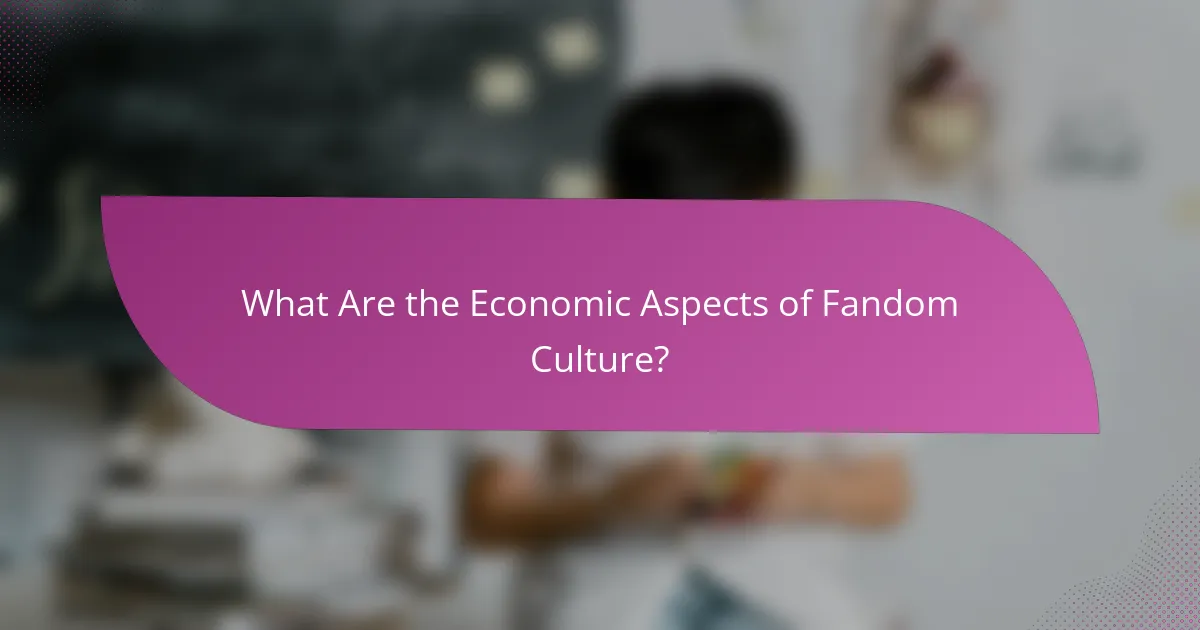
What Are the Economic Aspects of Fandom Culture?
The economic aspects of fandom culture encompass various revenue streams generated by fan activities, including content creation, merchandise sales, and funding for fan-driven projects. These elements highlight the financial impact and sustainability of fan communities in today’s digital landscape.
Monetization of Fan Content
Fan content monetization involves creators earning income through platforms that support user-generated material, such as Patreon or YouTube. Fans often pay for exclusive content, merchandise, or experiences, allowing creators to turn their passions into viable income sources.
Successful monetization strategies can include offering tiered memberships, selling digital downloads, or hosting live events. Creators should consider their audience’s willingness to pay and the value they provide to optimize their earnings.
Revenue from Merchandise Sales
Merchandise sales are a significant revenue stream for fandoms, with items ranging from clothing to collectibles. Fans often seek products that represent their favorite franchises, characters, or creators, driving demand for unique and branded items.
To maximize sales, creators and companies should focus on quality, exclusivity, and relevance to current trends. Collaborations with popular brands or limited-edition releases can enhance appeal and encourage purchases.
Funding for Fan Projects
Funding for fan projects typically comes from crowdfunding platforms like Kickstarter or Indiegogo, where fans support creative endeavors that resonate with them. These projects can include fan films, art books, or community events, often requiring significant financial backing to succeed.
Creators should clearly communicate their project goals and potential rewards to attract backers. Offering tiered funding options and engaging with the community can significantly increase the likelihood of meeting funding targets.
